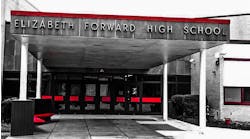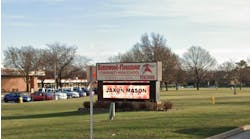Most discussions of fire containment center on issues related to flames and smoke. Yet the heat radiating from a fire also can become a deadly threat.
Imagine being trapped in a stairwell, lab or classroom during a fire. Even if the fire is kept at bay by the components of the building, temperatures could rise quickly to an unbearable level. Therefore, in places where people could be trapped during a fire, it is essential to consider the effects of radiant heat transfer.
Technology advances
Concerns such as this have led to the development of a new generation of fire-rated glass products. These products have achieved the status of a barrier wall because they block the transfer of heat from one side of the glass to the other. Even when a fire is raging on one side of the glass, an observer can touch the opposite surface of the glass. And, in the case of a fire in a residence hall or school building, the extra time these products can give people to escape or be rescued can mean the difference between life and death.
Sophisticated technology enables glass to perform in this way. Some of the new products that use this technology are constructed with one or more intumescent alkali silicate interlayers between multiple layers of glass. Others contain a gel substance sandwiched in the middle of an insulating unit. In either case, the interlayer turns to foam during a fire and creates a barrier to heat by blocking the radiation.
Fire-resistant glass can be specified for virtually any area, allowing floor-to-ceiling and wall-to-wall expanses of glass.
Compare the performance characteristics of transparent glass walls with those of more traditional fire-rated glasses that do not serve as barriers to heat transfer. (See Picture 1, p. 288)
Furnace tests of both types of products provide the data for comparison.
Initially, the differences on a time/temperature curve do not appear significant. (See Picture 2, p. 290) For example, after 30 minutes, the surface temperature of transparent walls has reached 662°F (350°C), whereas the monolithic glasses have reached 1022°F (550°C). Clearly, neither product can be touched without causing burns.
Still, at the 30-minute mark, the temperature of the transparent glass wall is low enough that someone can safely pass near it. This cannot be said for the monolithic fire-rated glass. At 1,022°F (550°C), someone would need to stay approximately 23 feet away from the glass surface to avoid the risk of being burned by the heat radiating from the glass.
For example, the radiation of a 1022°F (550°C) hot surface is three times greater compared with a 662°F (350°C) hot surface. A second effect increases this difference even more. Glass that remains transparent in a fire transmits a high part of the radiating furnace flames and hot inner surfaces. If one assumes a furnace temperature of 1562°F (850°C), then compared with the opaque glass with intumescent interlayer, the difference in radiation may be increased up to five times.
Picture 3 helps illustrate the effects of heat radiation on people. The intensity of the radiation in kW/m2 is plotted against the time it takes to reach the pain threshold.
When the intensity of the radiation from a fire is at 4800 BTU/sq. ft., the heat becomes physically intolerable, and people will run away after only two or three seconds. In that brief period of time, people must walk about 6 to 10 feet to remove themselves from danger.
A transparent firewall, with its temperature of approximately 320°F (160°C), emits approximately 320 BTU/sq. ft. heat radiation at a distance of 3.28 feet. This temperature can be endured easily for 1,000 seconds (15 minutes) or more.
Some furnace tests have shown a radiation of approximately 9600 BTU/sq. ft. from monolithic fire-rated glass, and approximately 6400 BTU/sq. ft. from monolithic glass with a radiation-reflecting transparent coating facing the fire. These values are slightly higher than those calculated from typical furnace and glass temperatures because of the oil burners used. However, the difference speaks for itself when these radiation levels are compared with transparent firewalls.
Be aggressive
The implications are clear: Careful thought should be given to the use of non-barrier-to-heat glazing along exit routes and other areas where radiant heat could become a threat to life safety.
If the goal is to protect people on one side of a glass opening from being burned when there is a fire on the other side, the maximum permissible level of radiation is about 2560 BTU/sq. ft. in a 3.3-foot distance. (Depending on the type of fire-rated glass used, this level or less can be maintained for at least 15 minutes). Adhering to this guideline also can help prevent the spontaneous combustion of flammable objects on the unexposed side of the glass.
Developing a comprehensive plan for fire protection will vary from building to building. However, equal emphasis should be given to all aspects of protection — from detection to compartmentation to suppression. Reliance on active protection systems, such as sprinklers, should not neglect passive protection, such as that provided by fire-rated glass. Transparent glass walls that provide a barrier to heat, flames and smoke will play an increasingly important role in designs of the future.
Zernial is director/conductor, fire-protection glass with Pilkington Deutschland AG Germany, an international company that specializes in glass and glazing products.

